

Sierra Wave
Newsletter
Volume 35, Number 1
September-October, 2016
Sierra Wave Newsletter
Volume 31, Number 4
March-April, 2013
Contents
- Events:
- Features:
- Reports:
- Business
Events
Upcoming ESAS Field Trips and Other Events
Evening Program, November 9th (Wednesday):
Colombia - Changing Landscapes with Santiago Escruceria
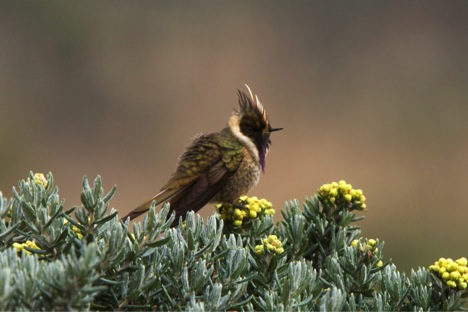
Buffy Helmetcrest (Oxypogon stuebelii)
Photo by Santiago Escruceria
Join us at 7pm on Wednesday, November 9th at the at the BLM/Forest Service Office in Bishop (by the DMV) for this program. Doors open at 6:30pm.
Colombia: Changing Landscapes
Guest speaker, Santiago Escruceria, will be giving a presentation on Colombia and changing politics and attitudes toward tourism, specifically birding tourism, at the Eastern Sierra Audubon’s November program.
Santiago Escruceria is a Colombian-born American citizen residing in California for the past 37 years. He has taught environmental education, in Spanish and English, for the past 22 years, 17 of which he has spent with the Mono Lake Committee. At Mono Lake he manages the Committee’s Outdoor Education Center program for Los Angeles inner-city youth. Santiago is an avid birder, leading bird walks in Colombia during the winter and walks for school groups and the public in the Mono Basin during the summer. He has been birding the Americas since 1986.
See you there!
Back to Top
 Antelope Valley/Topaz Lake Birding, First Friday of each month at 8am - Beginners Welcome! (Binoculars and bird books provided)
Antelope Valley/Topaz Lake Birding, First Friday of each month at 8am - Beginners Welcome! (Binoculars and bird books provided)
Join us as we look for resident and migrant species of birds throughout the beautiful Antelope Valley, including along the shores of Topaz Lake (in the northern part of Mono County).
Leader: Elena Espinosa (30+ years of birding experience)
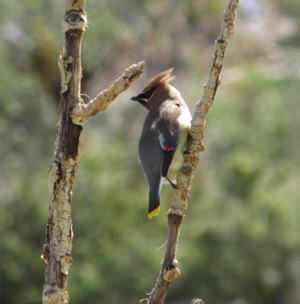
Cedar Waxwing in Mountain Gate Park
Photo by Dick Padgett
On Friday, September 2nd, we saw a large influx of raptors (Harriers, Red Tails and Kestrels so far) on Cunningham Lane. There's been a resident Spotted Sandpiper on the West Walker River at Mountain Gate Park along with Western Wood Pewees. We spotted 8 Sandhill Cranes on Topaz Lane. Western Bluebirds, a Shrike and Lewis' Woodpeckers were all spotted on Mill Canyon Road. There was a herd of Violet Green Swallows by the bridge on Larson Lane. The south shores of Topaz Lake also have a great assortment of interesting birds with the migratory ducks already spotted. In total, we counted 38 species for the day.
I hope to see you for breakfast around 7am on the first Friday of the month and then head out for the birding around 8am.
When: 8:00am on the first Friday of each month
Where: Sweetwater Coffee Shoppe at 107537 Hwy 395 in Coleville. The coffee shop makes delicious beverages and serves croissant, burrito and bagel breakfasts. Arrive at 7 to order before we head out at 8.
Contact Elena with questions or for more information: 928-300-8088 or espinosa2015@gmail.com.
Back to Top
 Monthly Bishop Paiute Tribe COSA, Bird Walk and Census Dates:
Monthly Bishop Paiute Tribe COSA, Bird Walk and Census Dates:
- Saturday, September 10, 7:30am
- Saturday, October 8, 8:30am
[Ed. Note: COSA walks are held on the second Saturday of every month, unless otherwise indicated]
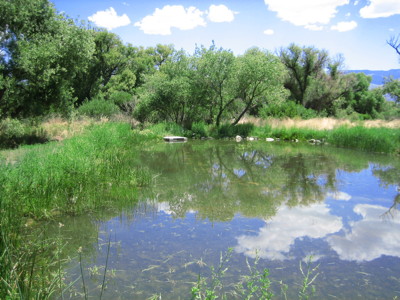
Spring has sprung in the COSA!
Unless otherwise indicated, our COSA bird walks will all be the second Saturday of the month, except (sometimes) for December, because we will have it coincide with the Christmas Bird Count. During June, July, August, and September they will start at 7:30 instead of 8:30. Watch the monthly email update, this field trips page, or local media for confirmation, updates on leader(s) and meeting time. Or, contact Hillary (below), or if you just show up at 8 or so, you'll probably find us!
The Conservation Open Space Area is being developed for wildlife and the community by the Bishop Paiute Tribe. We'll be keeping species lists and observing behavior as well as identifying birds, for the purpose of creating bird lists for the site. For more information, read this article on the COSA in the March-April 2013 Sierra Wave newsletter. There have been surprises every month so far - come find out what new birds we'll see next time - maybe you'll add toour bird list on e-Bird!
All are welcome - these walks are for birders of ALL LEVELS, beginners included! We will bring extra binoculars and field guides to share. If you'd like to print out a bird checklist, with blanks for adding your own discoveries, you can download that here: COSA Bird Checklist trifold (pdf)
Please meet at 7:30am in June-September, or 8:30am during October-May at the BLM/Forest Service Building on West Line Street in Bishop. Contact Hillary Behr for more information, or if you are interested in leading a future monthly walk: hillarybehr@yahoo.com.
Back to Top
Birding the Valley/Hiking the Valley, Northern Mono County, September 10-11
Birding the Valley / Hiking the Valley 2016 Itinerary
**BRING SUNGLASSES, SUNSCREEN, BUG SPRAY, WATER AND A HAT ALONG WITH STURDY SHOES and WALKING STICKS**
Friday September 9th
Arrive Friday and enjoy 10% discounts on selected meals and food items at local participating Northern Mono Chamber of Commerce members' locations (Sweetwater Coffee Shoppe, Meadowcliff Restaurant, Walker Burger, Walker Country Store and Walker General Store). Walker General Store also has a wide selection of DVD movie rentals!
Saturday September 10th
- 7am: Check in and complimentary breakfast at Walker Country Store 107700 US-395 in Coleville
- 8am: Depart for easy birding with local birder Elena Espinosa in Antelope Valley. Join us as we look for the 130+ species of resident and migrant birds that reside in our valley.
- Noon: Discounted lunches and lunch items at participating establishments (Sweetwater Coffee Shoppe, Meadow Cliff Restaurant, Walker Burger, Walker Country Store and Walker General Store).
- 2:30pm: Check in at Walker Country Store 107700 US-395
- 3-6PM: Emigrant Trail to Little Lost Cannon Creek Hike 4.5 Miles Round Trip with 1500' elevation gain. The remnants of the Emigrant Trail meanders through sage brush and bitter bush before meeting the creek where we cross to the north and follow the trail up through the aspens. At 2 1/4 miles and 1500' elevation gain, we reach the divide into Lost Cannon Creek. At this point we will turn around and retrace our steps.
Sunday September 11th
- 7-8am: Complimentary breakfast and check in at Sweetwater Coffee Shoppe 107537 US HWY 395, Coleville.
- 8am: Depart for Leavitt Meadows Birding/Nature Walk with Paul McFarland. Experience birding and nature in the coniferous forest along with taking in the spectacular display of the beginning of fall colors.
- Noon: discounted lunches at participating establishments.
- 1:30-3pm: Check in for Basque Stoneboy Hike at Walker Country Store and leave with local geologist guide Katy Buell. 2 1/4 miles Round Trip with 800' elevation gain. We will wander through aspen and sage before entering an older coniferous forest where the trail enters the Carson Iceberg Wilderness and starts to climb up to Stock Drive. Return by the same route.
- 5pm: participant discounted dinner specials at local restaurants
Questions?? Call 530-208-6078
Back to Top
 Inyo Craters Bird Walk, Sunday, October 16th at 8:30am, with Santiago Escruceria
Inyo Craters Bird Walk, Sunday, October 16th at 8:30am, with Santiago Escruceria
This will be a nice gentle walk around Inyo Craters, looking for migrants such as Evening Grosbeaks, Gray Flycatchers and hawks. We will also look for several species of woodpeckers, including the rare Black-backed Woodpecker and the White-headed Woodpecker.
Bring: good hiking boots/shoes, warm jacket, hat & gloves, snack and plenty of water for the outing. Scopes are not needed. A few extra pairs of binoculars will be available for use.
Meet: at the Inyo Craters Parking 3 miles north of the Mammoth Scenic Loop.
Directions: are available here: http://www.mammothtrails.org/trail/68/inyo-craters-trail/
For more information: contact Santiago Escruceria at guadualito@me.com.
Back to Top
Back to Top
Features
California Scrub-Jay and Woodhouse's Scrub-Jay
[Click on any photo to see larger, or all in a slideshow]
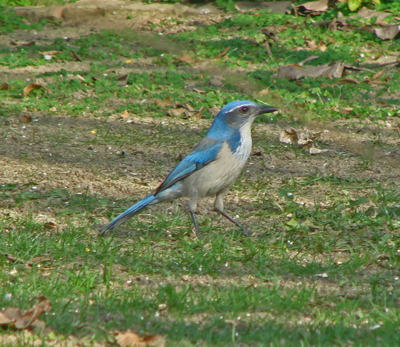
California Scrub-Jay, photo by Tom Heindel
Many of us were recently encouraged to observe "Sage Sparrows" more carefully when the American Ornithologists Union (AOU), recognized that what had been one species, "Sage Sparrows," was in fact two very similar species. These two species are the Bell's Sparrow, subspecies Artemisiospiza belli canescens in the eastern Sierra Nevada region and the Sagebrush Sparrow, Artemisiospiza nevadensis in the Great Basin. Remember, there is no longer a "Sage Sparrow."
We are now faced with a similar identification problem that involves the "Western Scrub-Jay." Research has indicated that "Western Scrub-Jay" is really two distinct species. This decision impacts those who bird the eastern Sierra Nevada since both newly recognized species are found here. "Western Scrub-Jay" is now either a California Scrub-Jay, Aphelocoma californica, known in the past as the "coastal" form of the "Western Scrub-Jay" or a Woodhouse's Scrub-Jay, Aphelocoma woodhouseii, known in the past as the "interior form" of the "Western Scrub-Jay." So now, the next time we observe a scrub-jay, we need to ask "which scrub-jay is this?" Remember, there is no longer a "Western Scrub-Jay."
The two species are superficially similar and have been reported to interbreed, thus all scrub-jays may not be identifiable in the field. With careful observation and given good views, most individuals should be. And remember, when in doubt, leave it out or enter the old "Western Scrub-Jay," which indicates that you didn't see it well enough to be sure which of the two new species it was.
The California Scrub-Jay is found over most of the state and is common on the west slope of the Sierra Nevada. They also occur on the east slope of the Sierra Nevada from the Kern County line north to Division Creek, about 11 miles north of Independence. Division Creek is the northern limit of oak trees on the east slope in our area and this is an important food source for this species. The California Scrub-Jay is also found on the floor of the Owens Valley near the towns of Lone Pine and Independence. This form in unexpected to the east of the Owens Valley in pinyon–juniper woodlands. That said, this does not mean that a wandering bird could not occur. Basing the identification of any bird only on location is not a good idea.

Woodhouse's Scrub-Jay, Grandview Campground, Photo by Tom Edell
The expected scrub-jay east of the Owens Valley is Woodhouse's Scrub-Jay. This species is known to wander, particularly during the non-breeding season, late August to late May, when they have been found on the floor of the Owens Valley and Death Valley and near Tecopa. They also have been reported breeding on the east slope of the Sierra Nevada south of Independence. There are many reports of this species, formerly called the "interior form," on the Bishop Christmas Count.
How do we know which scrub-jay we are looking at? We recommend a study of either of the two best field guides used by most serious birders, the National Geographic Society's The Birds of North America or the Sibley Guide to Birds. Both are excellent books and cover the two new species well. Since this two species split has just occurred, these books will have them labeled as Western Scrub-Jay with a coastal form and an interior form. California Scrub-Jay is much brighter blue dorsally and has a well defined partial breast band on the upper breast. It also has a bright white throat and line above the eye. Ventrally, the bird is paler than the dingy gray of the Woodhouse's Scrub-Jay. The bill is stouter and more strongly hooked than that of the Woodhouse's Scrub-Jay, better for opening oak acorns! With the Woodhouse's Scrub-Jay think "duller, grayer" and more slender-billed, better for prying out pine nuts from the cones. The "duller and grayer" is a trait shared by a number of bird species that occur in the Great Basin versus their genetic congeners who are west of the Sierra Nevada, which are the brighter ones. That is not a political statement! Remember the other rule: When in doubt—photograph it!
By Tom & Jo Heindel
Return to Top
Tom and Jo Heindel have contributed a vast amount of their knowledge to the Wave Newsletter over the years (from 1993 on!). Those articles have been archived for reference, here: Heindel's articles and season highlights.
Back to Top
Reports
Report: Owens Lake World Shorebirds Day - Michael Prather

Owens Lake Shorebirds, Photo by Tom Knudson
It was World Shorebirds Day Sept. 3, 2016 when I drove out onto bright and cloudless Owens Lake to census her birds. Sunrise and cooler temperatures made this a beautiful time of day anywhere, but here at the southern Owens Valley’s "blue hole" it was outstanding.
The extent of the habitat that has accidently been created to control dust at Owens Lake makes it impossible to cover all of it by myself so my plan was to bird the northern portions of the lake in dust control areas T36, 30, 29 and 28. A little over 5 hours later I completed the census and I wasn’t disappointed. I had seen 35 species of birds and 5,849 total individuals.
When you are alone and set your own pace, without the needs of others, wildlife observations with real drama and consequence appear. It is magic. While I watched large groups of black-necked stilts, the lake suddenly rose with cries of protest and alarm. At Owens Lake any time all the birds rise at once it means a raptor has arrived. A peregrine falcon streaked in low above the water, separating out smaller and smaller groups of stilts until it was just a string of 7 still flying. Immediately one stilt dropped out and settled into the belly-deep water while the peregrine circled, banked and dove. I’ve never witnessed a stilt duck under the water to avoid being taken, but this one did four times before the falcon broke off and coasted over to the next area still hungry. A northern harrier innocently flying nearby was strafed by the frustrated falcon. Birds show unusual behaviors when life and death are involved.

Owens Lake Shorebirds, Photo by Tom Knudson
Fall is the season of "brown ducks." It is a perfect time to practice identification when more involved and subtle skills are needed. Silhouettes, bill shape, difficult wing feather patterns, behavior and flight all provide the path to ID your bird. Northern shovelers have a hefty spoon-like bill. Gadwall show glimpses of a single white patch along their side - sometimes. Slender long necks in flight highlight the northern pintail. Practice makes good, not perfect, so get out there each fall and look.
On a flat muddy island less than an inch above the water level stood a dozen white-faced ibis. Their bodies and wings were twisted and hanging in the most bizarre poses. Necks bent in such unnatural positions made me wonder if this was some form of "ibis yoga." There was no sign of injury or threat of predator or need to display for a mating partner. This was mystery. When I returned home I researched this behavior and found that it is normal and is possibly a sunning pose or stretch. Such behavior on other birds such as roadrunners has also been reported. The more you go out the more you learn. Without question I learn new things every trip out birding and I’ve birded for 50 years.
Thirteen species of shorebirds total – a little below average. Twenty or more species in a day have been recorded over the years. My total of nearly six thousand birds pales when compared to the more the 100,000 birds found on a single day at Owens Lake. We are blessed with a Serengeti-like wildlife location in our valley, where you can spend days marveling at the undulating flocks of sandpipers and streams of peeps. With huge open space and few visitors, your have a front row seat at on of Nature’s most spectacular places.
My results were reported on eBird and sent to the recorders of this worldwide event. You can view them at: ebird.org/ebird/view/checklist/S31412053
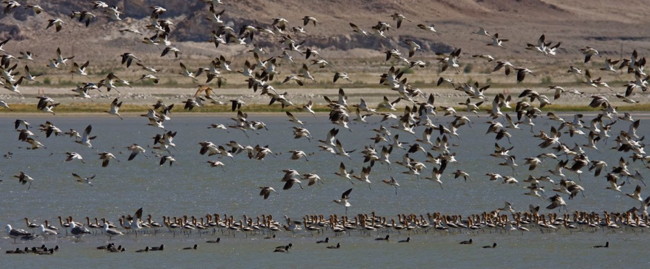
Large numbers of shorebirds at Owens Lake, photo by Tom Knudson
World Shorebirds Day - Still working on the nomination of Owens Lake to become part of the Western Hemisphere Shore Bird Reserve Network (whsrn.org). Had a good conversation with a LADWP senior manager yesterday - hopeful. Also spoke with a State Lands Commission staffer hoping to get on the agenda for the State Lands Commission agenda at their October meeting in San Diego - crossing my fingers. I started this work in early 2015. My goodness things take so much time.
Thanks to Tom Knudson for the photos.
Michael Prather
Back to Top
Taking Care of Business
Welcome New and Rejoining Members!
Thank you to the members who recently joined or renewed their membership!
We'd like to take a moment to promote Chapter Memberships: You may not be aware of this, but 100% of Chapter Membership dollars stays locally in the Eastern Sierra, supporting local education, youth, conservation, and programs. If you don't need Audubon Magazine, consider joining or renewing as a Chapter-only member, or better yet, as both Chapter and National! We do get support from National Audubon, as well, so any membership helps, and is money well-spent toward bird and wildlife conservation and education, and we thank you!
Your membership donations help keep this chapter alive. We get 8-10 renewing members a month, and from 3-5 new members. Your membership dues make it possible for us to offer and support great educational and recreational events throughout the eastern Sierra. Thank you!
If you would like to join and help support Eastern Sierra Audubon, there are two ways you can do it:
- Join as a National Audubon Society Member, designating ESAS as your chapter affiliation. Includes Audubon Magazine subscription. This is $20 for the first year, and goes up to $35 annually thereafter.
- Join as an ESAS Chapter-only Member for $20 per year. 100% of your donation stays here in the Eastern Sierra this way. Your chapter membership is a way to give back, and show your appreciation for all that ESAS does, and to help support our mission locally. Your membership helps pay for scholarships, programs, special events, education programs, research, and more. THANK YOU for your support!
Click Here for a membership form to join or renew!
Join National Audubon - your zip code will associate you with the chapter nearest you.
Back to Top
Message from the Editor
Our next newsletter deadline will be October 15th for the
November-December issue, and of course you are always welcome to send submissions for future newsletters
and also the monthly email at any time.
We send out about one email each month to remind you of upcoming events - if you are not
on our email list, please
add yourself so you don’t miss anything!
If you send items to the newsletter
editor by the last week of any month, we’ll make sure they get included in
the next issue.
All of our content is supplied by our awesome members... if you have any ideas about articles you’d like to see, or better yet, if you have anything to share for newsletter publication, whether an article, a news item, update, correction, poem, essay, artwork, photo, field trip report, neat birding experience, letter, etc, please send it, along with any comments or suggestions, to the newsletter
editor. We’d love to hear from you!
You may send items for inclusion in the newsletter at any time, but please
send any timely items to arrive before the first of the month, so they can
be included in the monthly email update.
Thanks for reading, and happy birding!
Newsletter Editor
Back to Top
Calendar for September-October 2016
Back to Top
Final Shot
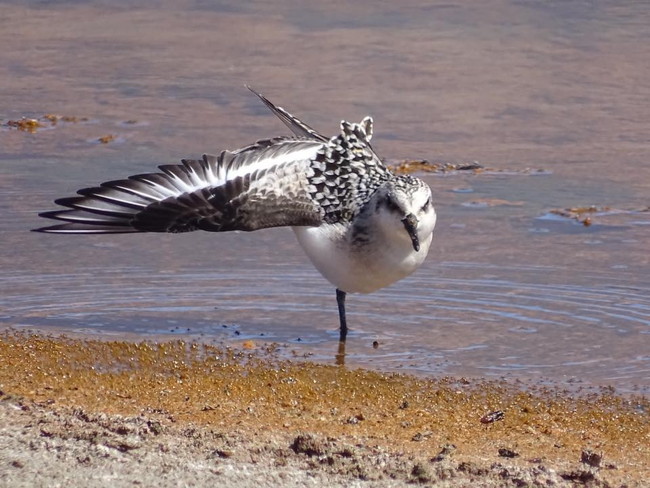
Sanderling Vogueing for the Camera, photo by Chris Howard
Back to Top














